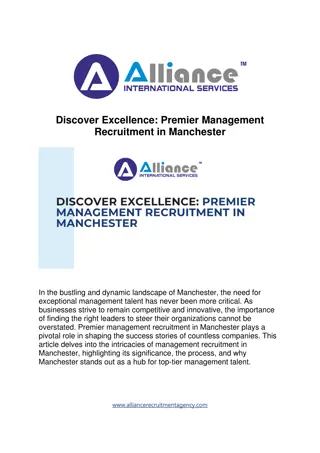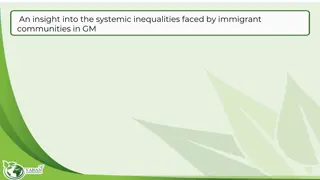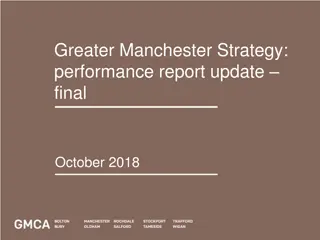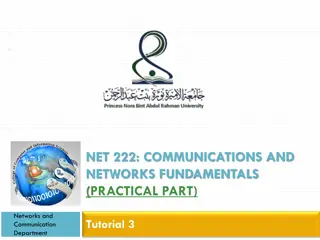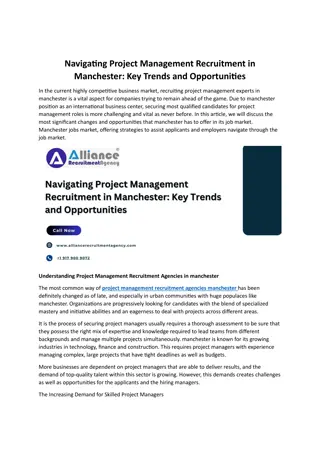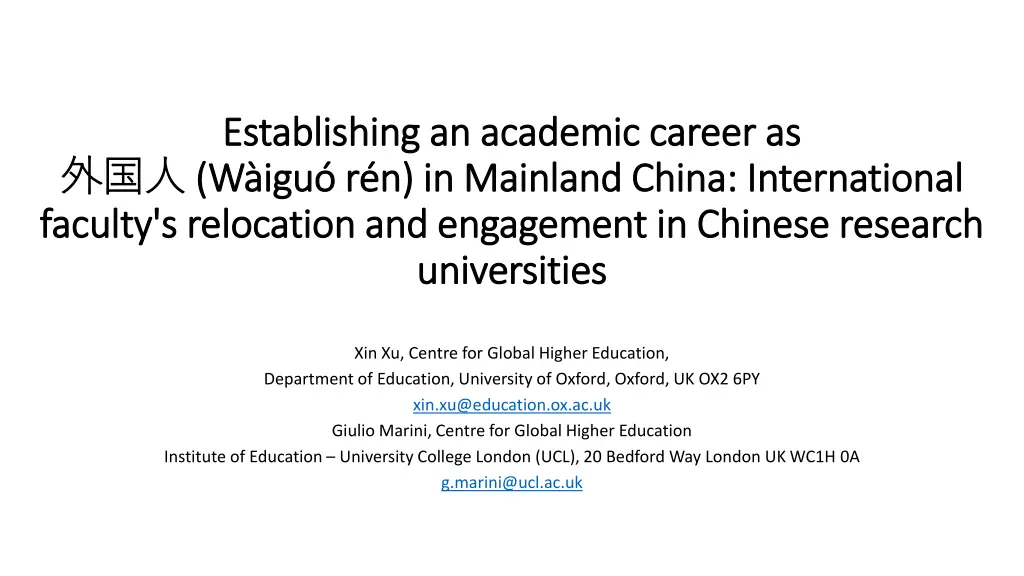
Academic Career Development for International Faculty in Chinese Universities
Explore the challenges and opportunities faced by non-Chinese scientists working in Chinese universities, aiming to understand the factors influencing the recruitment and retention of foreign talents. The research project involves data extraction, surveys, and in-depth interviews to delve into the complexities of this issue.
Uploaded on | 0 Views
Download Presentation

Please find below an Image/Link to download the presentation.
The content on the website is provided AS IS for your information and personal use only. It may not be sold, licensed, or shared on other websites without obtaining consent from the author. If you encounter any issues during the download, it is possible that the publisher has removed the file from their server.
You are allowed to download the files provided on this website for personal or commercial use, subject to the condition that they are used lawfully. All files are the property of their respective owners.
The content on the website is provided AS IS for your information and personal use only. It may not be sold, licensed, or shared on other websites without obtaining consent from the author.
E N D
Presentation Transcript
Establishing an academic career as Establishing an academic career as ( (W igu W igu r n r n) in Mainland China: International ) in Mainland China: International faculty's relocation and engagement in Chinese research faculty's relocation and engagement in Chinese research universities universities Xin Xu, Centre for Global Higher Education, Department of Education, University of Oxford, Oxford, UK OX2 6PY xin.xu@education.ox.ac.uk Giulio Marini, Centre for Global Higher Education Institute of Education University College London (UCL), 20 Bedford Way London UK WC1H 0A g.marini@ucl.ac.uk
Presentation Scientific/academic foreigners in China Project design First evidence Dimensions of analysis
The topic Non-Chinese scientists working in higher education institutions are essential to increase Chinese reputation and sustain global competition (e.g. Rankings) Foreigners are per se a signal of polarisation and quality China is surprisingly backward in attracting non-Chinese talents, if comparison is set to recent achievements We aim at understand what does prevent/ incentivate China to attract foreigners in Chinese universities Actually we now nothing about this specific topic
A tentative quick understanding of the topic Stage 0 to be autonomous from foreign technological transfer Stage a to open country to outflow Stage b to incentivise Chinese to come back Stage c to attract foreign Talents with policies Stage d to attract foreigners without policies
The project Secondary data extraction from official research-intensive website (i.e. staff directories) [census of foreigners in 4 universities, so long] Diffusion of a short questionnaire to collect some further information plus consent to qualitative interview (via getting email address) [in progress] In depth interview in China [yeah, we got funding for this!]
Qualitative phase: Dimensions of analysis for investigating what brought some foreigners there in mainland China Geographical distance Language barrier Academic culture Political-ideological traditions Family/personal/environmental factors Resources (research/financial/talent programmes, etc.) Other
Some numbers (secondary data source) China probably has around 0.1% of staff with non-Chinese nationality/passport in its higher education system, excluding: Transnational branches Post-docs Doctoral students Languages experts The UK has around 30% In Italy is around 1.1%
Sex and year of appointment in China
Origin: PhD attainment US UK Germany France Japan South Korea Switzerland Australia Italy Canada China Russia Singapore Spain 65 16 11 9 9 4 4 3 3 2 2 2 2 2 39.39 9.70 6.67 5.45 5.45 2.42 2.42 1.82 1.82 1.21 1.21 1.21 1.21 1.21 The Netherlands Belarus Finland Germany/US Hong Kong Ireland Italy/Switzerland Netherland Poland Sweden 2 1 1 1 1 1 1 1 1 1 1.21 0.61 0.61 0.61 0.61 0.61 0.61 0.61 0.61 0.61 Total Missing 145 20 87.88 12.12
References Brotherhood, T., Hammond, C. D., & Kim, Y. (2019). Towards an actor-centeredtypology of internationalization: a study of junior international faculty in Japanese universities. Higher Education, 1 18. https://doi.org/10.1007/s10734-019-00420-5 Huang, F. (2017a). Research in international faculty members recruitment in the international and comparative perspectives. Research Institute for Higher Education Hiroshima University, Japan. Huang, F. (2017b). Who are they and why did they move to Japan? An analysis of international faculty at universities (No. 27). Centre for Global Higher Education working paper series. Huang, F. (2019). International faculty in Japan. International Higher Education, 96(Winter), 18 19. Kim, T. (2010). Transnational academic mobility, knowledge, and identity capital. Discourse, 31(5), 577 591. Kuzhabekova, A., & Lee, J. (2018). Relocation Decision of International Faculty in Kazakhstan. Journal of Studies in International Education, 22(5), 414 433. Lee, J. T., & Kuzhabekova, A. (2018). Reverse flow in academic mobility from core to periphery: motivations of international faculty working in Kazakhstan. Higher Education, 76(2), 369 386. Munene, I. I. (2014). Outsiders within: isolation of international faculty in an American university. Research in Post-Compulsory Education, 19(4), 450 467. RIHE. (2014). the Changing Academic Profession in Asia: the Formation, Work, Academic Productivity, and Internationalization of the Academy. Rumbley, L. E., & De Wit, H. (2017). International faculty mobility: crucial and understudied. International Higher Education, 88(Winter), 6 8. Teichler, U. (2015). Academic mobility and migration: What we know and what we do not know. European Review, 23(S1), S6 S37. Wu, X., & Huang, F. (2018). International faculty in China: case studies of four leading universities in Shanghai. Asia Pacific Education Review, 19(2), 253 262. Yang, L., Marini, G. International Higher Education (2019) How are China s well-funded returned talents performing? Research productivity of Chinese Young Thousand Talents https://doi.org/10.6017/ihe.2019.97.10944 Yudkevich, M., Altbach, P. G., & Rumbley, L. (Eds.). (2016). International faculty in higher education: comparative perspectives on recruitment, integration, and impact. New York: Routledge.




